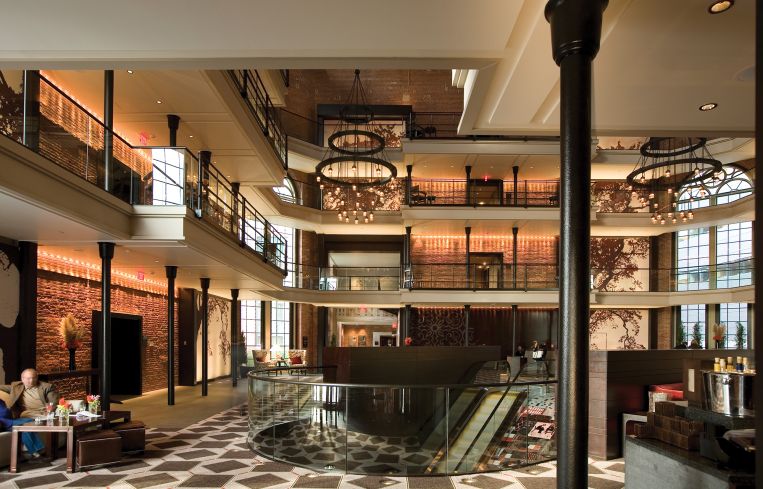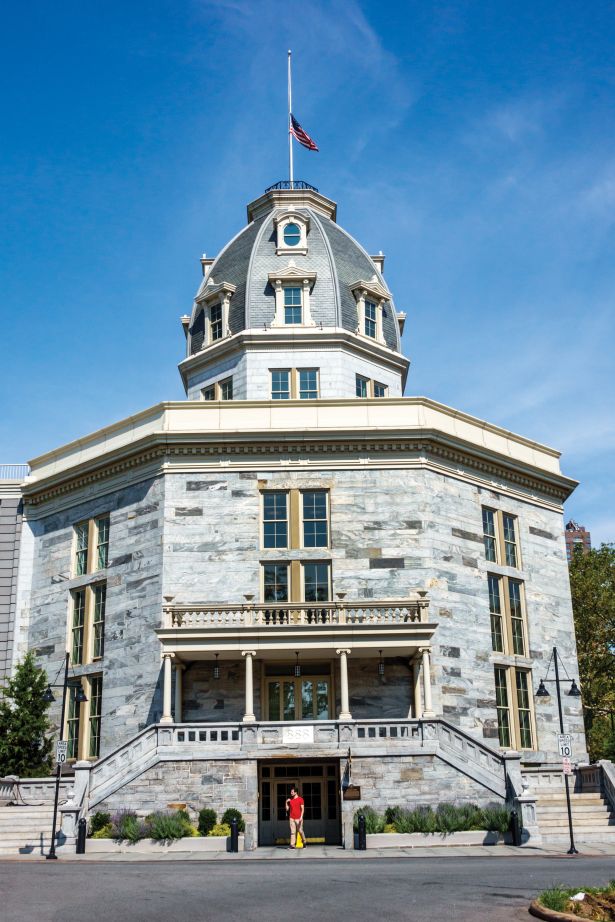How Developers Re-Enliven Real Estate With Unsavory Reputations
Gory crime scene? No problem. Haunted by a horrible history? Please.
By Isabelle Durso October 28, 2025 12:00 pm
reprints
Developers ain’t afraid of no ghost.
And neither are residents. More than half of Americans — or 52 percent — who say they have never lived with ghosts claim they would be brave enough to purchase a haunted house, according to a new report from brokerage Clever Real Estate.
What does that mean for developers? Well, it gives them a lot more leeway to convert old notorious properties — such as former prisons, hospitals or asylums — into housing. If residents don’t mind the haunted factor, why not give it to them?
“Sometimes when buildings are that unique and have that great a story, that’s something that’s very additive to the development,” Spencer Levine, president at development firm RAL Companies, told Commercial Observer. “There are extremes, but some of the more notorious sites are destinations. It’s certainly as much of an advantage as it is a detractor.”
That’s already been seen in New York City, where conversions — not just office-to-residential conversions — are on the rise, with many developers eyeing opportunities to transform abandoned landmarked properties into other uses. And New York, which just celebrated its 400th anniversary as a city last year, certainly has enough history to invest in, according to historian Kevin Draper, who runs New York Historical Tours.
For example, there’s the old women’s jailhouse in Greenwich Village that was converted into the Jefferson Market Library; the old carriage house at 17 Barrow Street — previously home to Alexander Hamilton killer Aaron Burr — that was turned into famed restaurant One if By Land, Two if By Sea; and then the former Scotto Funeral Home in Brooklyn’s Carroll Gardens neighborhood that was transformed into a boutique gym.
More recently, developers Camber Property Group and the Osborne Association worked to convert the former Bayview Correctional Facility in Chelsea into a 124-unit affordable housing project called Liberty Landing. And, in Harlem, a team made up of L+M Development Partners, Urbane, Infinite Horizons and Lemor Development Group was chosen to redevelop the former Lincoln Correctional Facility site into the Seneca, a 105-unit housing project with 7,500 square feet of community facility space.
But maybe New York City’s spookiest redevelopment so far was developer Becker + Becker’s transformation of the former New York City Pauper Lunatic Asylum on Roosevelt Island into the Octagon, a 650,000-square-foot housing complex that today boasts 500 apartments and several amenities.
Built in 1834 as one of the first institutions for the mentally ill, the asylum gained infamy in 1887 after journalist Nellie Bly went undercover as a patient at the institution and exposed the inhumane conditions she discovered during her 10-day investigation there. Bly’s widely read expose revealed the abuse, neglect and poor treatments patients on the island — then called Blackwell’s Island — received, and her work was later credited with forcing significant reforms in mental health care. The asylum shut down in 1894, and was used as a hospital until 1955.
The asylum’s legacy — and creepy history — certainly ensured that Becker + Becker’s redevelopment project more than 100 years later would get noticed.
“Every building has a unique history, and it’s always possible to find positive value in that historic building despite its history,” said Bruce Becker, president at Becker + Becker. “But sometimes the reputation of the building needs to be renamed. It was a building that rose from the dead.”
That process started with architects Philip Johnson and John Burgee, who developed a master plan for Roosevelt Island in 1969. The master plan envisioned turning Roosevelt Island from a dirty, grimy place for hospitals and asylums into a pedestrian-
focused, car-free community with housing and green spaces. And, in order to achieve that vision, the abandoned asylum had to be redeveloped.
The property had been through several fires by the time Becker entered the picture in 2006, leaving only the main entry pavilion as a building starting point. Becker’s plan was to build new residential apartment wings where hospital wings once existed using the bones of the pavilion, but he ran into some complications regarding the property’s landmarked status.
To move forward with construction, Becker had to get approval from the National Park Service, the State Historic Preservation Office and the New York City Landmarks Preservation Commission, as well as navigate conflicting design direction from the government agencies during the process. As you could guess, that all made his development timeline a lot longer.
Stephanie Friese, a partner at law firm Bradley Arant who has worked with clients on many of these types of conversions, said developers are often forced to succumb to the government’s direction when it comes to historic properties such as the Octagon.
“The government may have so many master plans or zoning overlays that it doesn’t matter what a developer wants to do,” Friese said. “Ultimately, they’re going to have to work with the government to figure out how we can conform this to what the community wants and the government wants things to look like. So that public-private partnership becomes important.”
Through that partnership, though, Becker said his firm was able to cover about 20 percent of the cost of the $170 million project, allowing him to restore some defining elements of what became the Octagon, such as its six-story spiral staircase in the atrium.
“It’s just such an amazing architectural feature,” Becker said. “I think there’s something to be said for trying to preserve history. In all its chapters, there was as much joy and celebration in that building as there was a reform and evolution of health care. The history of that building is as rich as the history of the city.”
Now, the Octagon stands tall as a 500-unit housing community featuring a day care center, a waterfront park, six tennis courts, a general store and underground parking. Becker said the redevelopment has also brought in a “whole new group of younger people with families” to Roosevelt Island.
“The neat thing about remaking these old buildings is that you’re reconnecting a lot of people who still have a history there, like the people who worked in the building,” Becker said. “You’re giving people a way to reconnect with their past.”
But sometimes the creaks and groans of an old building with an unknown history are unnerving. That was the case at RAL’s One Brooklyn Bridge condominium project at 360 Furman Street in Brooklyn Heights, which was formerly a shipping center and was redeveloped by the firm in 2006. The property now comprises approximately 435 condo units, a 3,000-square-foot gym, a yoga and Pilates studio, a screening room and more.
“When you take over an empty industrial building like that, and you’re just one person in a million square feet, who knows what’s going on in there,” Levine said. “There’s this super spooky life that happens in those pre-development days. When we took that building over, things would move and doors would be open.”
It turned out there was actually someone living illegally in 360 Furman Street as RAL was redeveloping the space.
“It was just one of those stories that had a super ghost-like quality to it,” Levine added. “It’s not just the spirits that come with buildings that you end up developing. It’s the history of who’s using them and who’s living in them, perhaps.”
There’s certainly some spirits at Boston’s 215 Charles Street, one of the most famed redevelopment projects in that city.
In the early 2000s, developer Carpenter & Company and architect CambridgeSeven redeveloped the historic Charles Street Jail — also known as the Suffolk County Jail — in Boston’s Beacon Hill neighborhood into the 298-key Liberty Hotel, which is now widely considered one of Boston’s top luxury hotels.
Before it became an elegant hotel, the property had a dark history. Originally constructed in 1851, the Charles Street Jail hosted some notable prisoners in its heyday, including civil rights activist Malcolm X (then known as Malcolm Little), mob boss Whitey Bulger, and even James Michael Curley, a former mayor of Boston who was busted for taking a civil service exam under a false identity.
After the jail closed in 1990 over accusations of overcrowding and poor conditions, the property sat dormant for about 10 years, because the property’s owner — Massachusetts General Hospital — did not know what to do with it, according to Timothy Mansfield, CEO and president of CambridgeSeven.
Eventually, Carpenter & Company proposed redeveloping the property into the current Liberty Hotel, which opened in 2007.
But the adaptive reuse project took some time. Like the Octagon, the Liberty Hotel project endured “an incredibly rigorous permitting process” with various state and federal agencies, including the Massachusetts Historical Commission, the Boston Landmarks Commission, the then-Boston Redevelopment Authority and the National Park Service, according to Mansfield.
“It went through a very significant review, and the ultimate goal was to create this wonderful new place in the city, a place of welcome,” Mansfield said. “So you’re transitioning what was once a formidable type of place to one that opened its arms to the city, and now it’s become this beacon at the end of Charles Street.”
And, while there were certainly challenges from collaborating with agencies on the project, Mansfield said working on the jail was one of the highlights of his career, as it’s “always fun” to work with an existing historical structure “as the starting point for a transition.”
CambridgeSeven certainly had a lot to work with. The firm incorporated much of the jail’s original infrastructure into the hotel’s current design. That included the big glass windows and the catwalks running around the main lobby, which guards once used to check on prisoners, as well as cellblocks and the jail’s central atrium lobby. Some of the actual cells were also used for the hotel’s design at its restaurant “Clink” and bar “Alibi.”
“We really embraced the idea of the ‘jailness’ of the building,” Mansfield said. “We said, ‘How do we transition this from a place that was very dark and rugged into a place of gathering and celebrations and being together?’ And so our goal from the design was actually to embrace it and see how we can do that. It is a terrific celebration of taking a building that had incredible bones and embracing that design and transforming it into something new.”
And guests love the prison-like elements in the hotel, as those architectural features “tell a story about the building,” and “people love stories,” Mansfield said.
But there’s also certainly a spooky energy at the hotel, with some guests reporting seeing the spirits of prisoners and guards still roaming the halls. Mansfield said he felt that same “dark energy” when he first toured the property.
“I have to tell you, walking into this abandoned jail that had been abandoned for 10 years was the creepiest thing that you could imagine,” he said. “You could just sense that there was this very dark energy, which is sort of natural by the building type, of course.”
That creepy feeling seems to be involved in most prison conversions in the country.
The former Lorton Reformatory in Lorton, Va. — which was notorious for its overcrowding, violence and poor conditions, and gained a reputation as the “prison from hell” due to frequent riots, escapes and murders — was redeveloped in 2017 into a multi-use complex called Liberty Market.
The complex features 165 luxury apartments, 157 townhomes and 24 single-family homes, as well as commercial spaces, a gym and a pool. The complex also features the Workhouse Arts Center, which preserves some of the historic buildings from the prison. And, while it’s a beautiful and safe place to live now, some tenants of the prison-turned-housing community said they certainly felt some “spooky” vibes on their first nights there.
Farther down south, there’s been quite a bit of conversion activity, too.

In Florida, the former Miami Heart Institute hospital was redeveloped by Lionheart Capital into a 110-unit luxury condominium complex called the Ritz-Carlton Residences, Miami Beach, which opened in 2020. The property has some pretty dark history, as the hospital was previously used as a military hospital during World War II.
While the property has since been revamped and is leasing up extremely well, there was definitely some initial difficulty selling the units due to the site’s past, according to Ivan Chorney, a real estate agent at Compass who worked on the project.
“It just always had this kind of negative aura about it, because people knew it was a hospital,” Chorney said. “They said, ‘Am I going to see ghosts in the hallway?’ And so it was a pretty hard project to sell. It was an absolute no for a lot of people.
“A lot of my clients will only buy new, and I mean new pipes, new everything,” Chorney added. “They don’t want to even think that there was another person walking in that unit in any kind of iteration before — real person or ghost.”
(Interesting side note: According to Chorney, in most states, you don’t have to disclose to buyers that a property is known to be haunted unless it has been publicly advertised by the seller.)
But that kind of information certainly had to be disclosed when selling a property as notorious as Jeffrey Epstein’s 14,000-square-foot compound in Palm Beach, Fla. The convicted sex offender’s mansion was sold twice after his death in 2019.
In 2021, local developer Todd Glaser purchased the property for $18.5 million, and then tore down the mansion and changed its address to mask its association with Epstein. Later in 2021, Glaser sold the lot for nearly $26 million to Boston-based venture capitalist David Skok, who has plans to build a custom house on the land. Skok’s project will feature six bedrooms, a library, a courtyard, a swimming pool, a pavilion and a guesthouse, according to Realtor.com. The project is nearing completion.
A similar renovation occurred at Epstein’s mansion on Manhattan’s Upper East Side at 9 East 71st Street. Former Goldman Sachs executive Michael Daffey, who bought the
seven-story townhouse in 2021 for $51 million, recently completed a $925,000 renovation at the property, including knocking down numerous walls and stripping previous light fixtures and ceilings, the New York Post reported.
Despite the infamous name associated with those properties, historian Draper said people will always buy homes with dark histories.
“Those houses are still multimillion-dollar houses,” Draper said. “Even if a murder happens and a house is haunted, people will still buy it. In the news today, out tomorrow.”
It’s important, however, to think about how the public will perceive conversions of such notorious places. At a property like Epstein’s Florida mansion, the changes to the land and address were likely more than welcome. But with developments like the Octagon and the Liberty Hotel, how did the cities’ communities receive those projects?
“I think with any development and any change, there’s going to be conversations that we have to deal with,” Mansfield said. “In the case of Liberty, this was a very welcome development, because the site had been so derelict for so long. It’s become something that I think the community really embraced.”
Levine agreed, but highlighted the difference in converting properties like prisons versus health care institutions like hospitals.
“I think a community would be not necessarily resistant, but hesitant, to the removal or demolition of a hospital, more than they would be to something like a prison,” Levine said. “But you never really know until you approach a specific project and its history.”
As for Becker, he said it really comes down to a “fear of change” in many locales.
“I think communities are justified in being skeptical about development, because most new developments that we’ve seen in American cities aren’t embracing things of historic and cultural importance,” Becker said. “But I think that when you redevelop a historic institutional building, there’s a way to do that.
“And, on the theme of Halloween, I would say it’s better to have buildings rise up from the dead than stay dead forever,” Becker added.
Isabelle Durso can be reached at idurso@commercialobserver.com.



